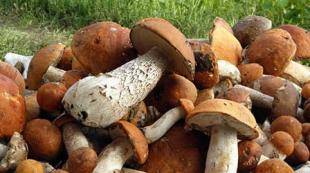Should roses be pruned during flowering? Summer pruning of roses after flowering - How to prolong the life of flowers
The rose is the queen of all garden flowers. A graceful, lush and elegant rose will decorate any garden, bringing a touch of romance and aristocracy into it. It cannot be called an unpretentious plant. You have to fight for beauty in the garden. Caring for rose bushes is a responsible occupation that requires certain knowledge, skills and time. spring pruning, proper watering, pruning roses after flowering and shelter for the winter are the main steps in caring for flowers.
Florists advise cutting roses several times a year: in spring, summer and autumn. In addition to the three main procedures, sanitary pruning should be carried out, which consists in removing old unwanted shoots, faded buds and diseased leaves. Properly performed regular pruning guarantees the bush:
- Rejuvenation of the bush, which leads to faster growth and vegetation.
- Resistant to winter frosts and immune to most garden diseases.
- Abundance of young buds and bright bloom summer.
- Decorative and aesthetic bush.
- Strengthening the root system.
- The distribution of the resulting nutrients evenly throughout the bush.
Basic rules for pruning roses
Despite the season of the event, there are a number of basic requirements for pruning rose bushes. First of all, take care of the choice of tools. Have a sharp, clean pruner and lopper on hand. Store garden tools in a dry and clean place: unsanitary conditions lead to the spread of diseases throughout the garden. Do not forget that the bushes are covered with thorns, so take care of your hands by wearing thick gloves.
The cuts can not be made even, observe the slope of 45 degrees. Always remove dried branches and faded buds that take away the strength of the bush, obscure it and violate the aesthetic beauty of the flower garden. Keep your tools sharp. The cut should be clear, without torn edges and breaks. After circumcision, the "wounds" are treated with an antiseptic (for example, alcohol).
Pruning after flowering
Summer pruning is an important stage in the development of a rose bush. After the first flowering, it is important to carry out the right event that will add strength to the plant. First of all, in the summer the rose should be cut to form an even beautiful bush. An overgrown rose may produce too many shoots to bloom. flowers in excess lead to a neglected view of the rosary. In addition, shading the bush leads to excessive moisture content and provokes the development of fungi. Weak and too late shoots should be removed immediately.

The second important step is pruning after flowering. Dry buds shade the plant, take away from it vitality and do not give growth to young shoots. You need to cut off not only faded buds, but the entire shoot under the root, leaving one bud above the ground. A strong young shoot will grow out of it, which will release flowers the next year. The cut part can be cut and planted in the ground or potatoes, and used as a cutting. By mid-August, as a rule, 2/3 of the bush is removed.
Pruning climbing roses
Curly roses bloom in their second year, so do not prune during the first year. Blooming buds of medium size - up to 10 cm. Climbing rose blooms along the formed horizontal lashes, and the buds also bloom on lateral shoots.
It is advised to start pruning climbing roses after flowering in late August or early September. First of all, all diseased shoots are removed. Leave 15 cm from the base. Those shoots on which there was flowering are shortened by 3 buds. To stimulate the formation of basal shoots, select 2 old branches and shorten them, leaving 30 cm from the base.
During flowering, sanitary pruning is acceptable. Removing dried inflorescences of climbing roses prolongs the period of a summer riot of flowers. Remember, you need to shoot only the inflorescence, without touching the shoot. Remember that a properly conducted event guarantees almost continuous flowering.
The rose survives well at home with the provision of decent care. For indoor plants there are certain rules of care: timely watering, top dressing, appropriate air humidity, temperature and pruning. To ensure high-quality and abundant flowering in winter, the plant must rest. During rest, watering is significantly reduced, top dressing is not performed, the plant is taken out to a warm sunny room.

The main pruning is done during the winter rest of the plant. On strong main shoots, 5 buds are left, and on small ones, 2 or 3 (or not left at all). It depends on the desired size of the bush. The more shoots on it, the smaller the flowers will be. In summer, the home rose is pruned regularly. It is necessary to immediately remove the faded bud. It takes away the strength of the plant, obscures it and provokes the development of fungal diseases, to which roses are very susceptible. Do not forget about dried leaves, which must be removed in a timely manner.
Rose care - hard work which requires experience and knowledge. But the beauty of this flower compensates for all the forces spent on its development. This is a real decoration of your home and garden.
For pruning roses you will need sharp secateurs with two cutting blades, working on the principle of scissors. Such a pruner gives an even and clean cut, does not crush the stems and does not exfoliate the bark. It is desirable that it be used exclusively for working with roses. From time to time, the tool should be disinfected and sharpened, and lubricated with machine oil for the winter.To remove thick branches, prepare delimber with powerful handles working like a lever. And finally, it will not be superfluous garden saw for cutting thick old shoots that cannot be removed otherwise.
A good pruner should make an even and clean cut without crushing the stem.
Cut shoots obliquely(at an angle of 45º) to the outer kidney, stepping back from it upwards by 0.5 cm. It is wrong to make a cut towards the kidney, in this case water will roll down to it and it will eventually rot. The cut is made exactly on the external kidney to form the correct vase-shaped bush. In this case, new rose branches will grow along the outer contour, and not inward, which is highly undesirable. It is not recommended to cut across the trunk, leave stumps - they will then dry out and become a gateway for diseases.
Sections that are larger than the thumbnail should be covered with a special paste (for example, Rannet) or garden pitch. This will protect the plant from infection, and will also prevent the loss of juices and the drying of the branches of the rose.
To protect your hands from scratches and cuts, pruning should be done in tight, preferably leather or suede gloves, in extreme cases, made of thick tarpaulin, with high, up to the elbow, cuffs such as cuffs.
2. Types of pruning roses
In the first lesson, we already wrote about the types of pruning, but let's list them again, applying this knowledge specifically to roses. By goals, they distinguish: sanitary, rejuvenating, shaping, stimulating and seasonal pruning.Sanitary
Sanitary pruning comes down to removal in the spring of poorly overwintered shoots- blackened, brownish, ringed brown spots the so-called infectious burn. They must be removed without regret and as soon as possible, immediately after you release the roses from the winter shelter. Experience has shown that attempts to save such shoots do not lead to anything good - they eventually dry out, but remain a source of the spread of diseases. Therefore, they must be disposed of without regret. Cut to healthy wood, but in stages, in parts (so as not to cut off the excess)! Removed shoots must be collected and burned.
Anti-aging
Radical anti-aging pruning essential for prolonging the life of a rose. The biological cycle of this plant involves the mandatory removal of old shoots in order for new ones to grow in their place. The rose has an amazing regenerative ability that allows it to prolong its life. With proper agricultural technology and competent pruning, it can grow in one place for more than 20 years! Therefore, annually in the spring, remove old, lignified three-year-old branches. Aged shoots are easy to distinguish from younger ones: they, as a rule, have lost their green color and have a somewhat “dried” appearance. Old wood conducts nutrients from the root worse, such branches bloom poorly.If we do not resort to radical pruning of the rose, then we will doom it to slow aging and dying. The cause of death is often the lack of anti-aging pruning. Removing old shoots on the ring gives impetus to the growth of new young and strong shoots. In addition, with each such shoot, a new root grows.
If roses show fading of growth, weak flowering, this means that in the spring it is necessary to update the bush, return it to an active life. To do this, subject it to radical pruning - leave only 2-3 of the strongest shoots, remove the rest to the ring. This will cause the rapid growth of new shoots, of which 3-4 of the most powerful should be left in summer or closer to autumn - they form the future skeleton of a rejuvenated bush. At the same time, in the spring, it is necessary to give the rose enhanced feeding, add rotted manure and a mineral complex with micronutrient fertilizers to the root zone. To stimulate the growth of new roots, be sure to spill the soil with a solution of "Heteroauxin" (100 mg / 10 l of water) or "Kornevin" (1 sachet per 5 l of water). And supplement this procedure with two full-fledged dressings in the summer.

It is necessary to cut old shoots into a ring, leaving no stumps. Stumps on the neck of a grafted rose will prevent the awakening of new buds and the growth of young shoots. Rooted roses should be cut at ground level.
Formative
After carrying out sanitary and rejuvenating pruning, the frame of the bush will begin to emerge from the remaining branches. After that you can begin to form the main skeleton of the rose, achieving a vase-like shape, open to the sun. Remove weak overgrown twigs from the bottom of the bush that will never bloom. Also, the plant does not need rubbing and competing shoots - of the two, leave the one that is stronger. The same technique is used when only one of the three branches grown from one kidney should be left. To lighten the bush, cut out part of the second-order shoots that look inward. In this case, all the shoots of the rose will be evenly lit by the sun, and the bush will turn out to be harmonious. With formative pruning, blind shoots without buds are also removed. If this happens, it means that the rose is either not getting enough sunlight or is overfed. At proper care every shoot is bound to give buds and flourish!stimulating
Stimulus pruning exists in order to make the rose put out new shoots. The weaker the shoot, the stronger it should be cut. And vice versa - the stronger the shoot, the less it needs to be shortened.
3. Timing of pruning roses
spring
Spring pruning roses considered the main. At this time, a basic set of activities is carried out. After you have freed the roses from the winter shelter, you need to carry out sanitary pruning. Next, remove the old three-year-old shoots and only after that proceed with the forming pruning. It is better to carry it out before the leaves have blossomed, but the buds have already swelled - in this case, the strongest ones are visible at the ends of the shoots. It is on them that the branches should be shortened. After trimming the ends, they begin to remove the shoots that thicken the bush. Get rid of thin unproductive twigs with a thickness less than the diameter of the pencil. Strive to create a vase-shaped bush open to the sun.
Summer
Summer pruning basically comes down to removing faded flowers to the first "real" cinquefoil leaf. This pruning regulates flowering, causing the rose to produce new flowering shoots. Cut to the outer bud - this will maintain the "open" shape of the bush. Otherwise, it will branch inward. Also remove blind shoots without buds, but they are not cut out entirely, but 2–3 well-developed cinquefoils are left on each. Do not confuse blind shoots with basal ones (from English word base - base, foundation), growing from the neck with replacement shoots. They appear as a result of measures to rejuvenate the bush and are extremely valuable for the later life of the rose. They must be protected!
Also in summer carry out light corrective pruning, removing dried stumps, branches unsuccessfully growing inside the bush, unproductive shoots below. At this time, you have a chance to correct the mistakes made during spring pruning. Summer pruning is carried out until the end of August, and then only fading petals are cut off, giving the rose the opportunity to set seeds. This will serve as a signal to her that it is time to prepare for winter and stop growing.
autumn
autumn pruning is carried out before laying roses in a winter shelter. As for the group of hybrid tea roses and floribunda, according to the existing rules, their shoots should be shortened: half for hybrid tea and 1/3 for floribunda. Of course, this approach attracts with its lightness, there is no need to think too much - I cut off half of the bush and that's it. And it is easy to cover, you can not bend the shoots, etc. But according to my observations, such a radical method is extremely harmful to powerful hybrid tea roses, and floribundas too. There is an imbalance between the developed root system and the defective truncated ground part, which is unable to nourish the roots on the eve of winter, which negatively affects winter hardiness.And here they are also advised to remove the leaves, because of their possible decay under cover. But remember that the rose is an evergreen plant! Rotting leaves are a lesser evil compared to the threat of losing the bush. Removing the leaves weakens the plant, in the spring it takes a long time to recover(even if it successfully overwintered). Most hybrid tea roses die, apparently, only because of the barbaric autumn pruning. So better in autumn carry out gentle pruning, do not deprive the rose of the vegetative mass, which during this period nourishes the roots, sending them the nutrients necessary for a successful wintering. It is better to leave everything until spring, when it will already be clear that it has not overwintered. Then cut.
It is preferable to plant varieties with flexible shoots that are easy to hide in a shelter. And let nature itself decide which of them will continue the life marathon. Therefore, for all roses without exception, at this time, only unfaded buds, non-lignified tops, which will inevitably be damaged by frost, should be removed at this time, as well as juicy strong red (very sorry, but there's nothing to be done!) fatty shoots that the rose, having hesitated, released too late and they obviously won't survive.
4. Pruning by groups of roses
Distinguish according to degree short(strong) middle(moderate) and long(weak) pruning. The degree of pruning depends on the group to which this or that rose belongs. In particular, scrubs, semi-climbers, ground cover roses do not need strong pruning. In the spring, you can only shorten them slightly and carry out sanitary pruning. The same sanitary pruning is done for ramblers, in which the tops of the shoots often freeze.
Pruning hybrid tea and floribunda roses
If these roses were pruned back in the fall, sanitary and rejuvenating pruning awaits them in the spring. Of course, the rejuvenating procedure will stimulate the growth of new shoots, so it is best to do it in the spring, leaving no more than 5-6 trunks and 40 cm above the ground. After the first flowering in summer, the shoots of hybrid tea roses are shortened by 20 cm.It must be remembered that flower stalks hybrid tea roses grow from both old and new wood. Therefore, the old shoots of the past two years bloom first (we remove the three-year-old ones in the spring), then the newly grown ones begin to bloom, which ensures the continuous decorativeness of these roses.
The same can be observed in floribunda. Stimulation of new shoots occurs both with the total removal of the old three-year-old shoots to the ring, and with the shortening of the remaining ones by 1/3 of the length. On old shoots, flowering occurs earlier, and only then does it begin on newly grown ones. With a balanced number of last year's and new shoots, almost continuous flowering can be achieved. After its first wave, cut the faded shoots, leaving 25–30 cm, and shorten the branches of the second order by 2–3 buds.

Pruning climbing roses
Faded branches of once flowering ramblers are advised to cut into a ring immediately after flowering so that new shoots have time to grow, which will bloom next year. This is justified with a long autumn and warm summers, which in middle lane are not so often. Rather, it is a recipe for southern regions our country. In the Moscow region, it is better to do this only before laying in a shelter, allowing the rose to gain strength for the winter due to the leaves of old shoots. And on good nutrition new lashes grow without additional stimulation. For grafted roses, ramblers leave from 3 to 6 shoots; for own-rooted roses, 20 shoots are allowed. After flowering, you can shorten the crown of new shoots by 5-7 cm to stimulate the growth of side branches.Pruning large-flowered climbers and scrubs
These semi climbing roses, as a rule, bloom again, so the main period for their pruning is spring, when sanitary measures are carried out. In the same period, the lashes are shortened to the first strong kidney. Remove up to 1/3 of the stem length from this group of roses after flowering in the summer to allow branching and a new wave of flowering. Important! Cut old shoots in autumn, leaving 30 cm above the ground (not on the ring!), Leave 2-3 buds at the side branches.Contrary to the recommendations encountered, do not try to form a bush rose from a climber or high shrub with strong pruning - by doing so, you will cause great damage to it. It will take a long time to recover from this barbaric procedure, spend time and energy on growing new shoots, which, at best, will bloom in the second half of summer.
Trimming scrubs - like old ones garden roses, and modern varieties– comes down to fairly light corrective pruning. In once-flowering, it is carried out in the summer after flowering, for remontants - in the spring. The stems of high scrubs at this time are shortened by 1/3, and for those below 1.2 m - by 1/2. In the summer, after flowering, flower stalks are cut off. Starting from the third year, gradually remove 1-2 old shoots annually. In single-blooming, this can be done in summer, and not only in spring, as in other groups.
In ground cover roses, many of which also belong to the scrub group, excessive thickening should be corrected to which they are inclined. In the spring, cut out old shoots and trim with clippers. hedge, giving the bush the desired shape, for example, a ball.

Ground cover roses need to regulate the thickening of the bushes
5. General rule for all grafted roses
Very important remove root shoots from dog rose rootstock(Rosa canina). Her appearance is extremely depressing scion. If the growth is not fought, growth will begin to fade, and the rose will eventually die. The root shoot has rosehip leaves, which differ in color from the cultivated scion, and seven leaves - it is not difficult to identify it by these signs. Coppice shoots cannot be cut at ground level - instead of one, two new ones will grow. It is necessary to dig up the ground and remove the shoot directly from the neck, sprinkling the cut with ash.There is nothing incomprehensible about pruning roses. The main thing is to rejuvenate them in a timely manner, stimulate the growth of new basal shoots and branching, carry out gentle summer and autumn pruning, and also remove root shoots.
In growing roses, one of the main secrets is competent pruning. About how to do this, how the procedure differs in spring, autumn and as it fades, as well as everything else you need to know for correct formation and development of the rose, is described in this review.
When is the best time to prune roses?
The question of when exactly you need to prune roses arises for beginner flower growers in the first place. The answer to it is determined by several factors, in particular, the type of plant, its age, climate zone and growing conditions (greenhouse or open ground), as well as the result expected to be achieved.
However, the correct pruning of roses should be carried out twice a year - in spring and autumn, and, contrary to the existing misconception, the most important and responsible procedure is carried out at the beginning of the season, and not at its end. 
After winter, almost all types of roses should be sanitized. Its purpose, first of all, is to remove all old, dried and frozen stems, which will not only provide the bush with a healthy and beautiful appearance, but also stimulates the formation of a large number of young shoots, on which new buds will be laid.
In addition, at this time you need to get rid of the active shoots at the base of the plant, which will divert its vital juices and prevent active flowering. Also, the purpose of spring pruning is to give the bush a beautiful and neat shape.
The procedure is carried out when the frosts have already completely receded, the rose has woken up, but new shoots from swollen buds have not yet begun to grow. Depending on the climate zone and weather conditions, this period may fall at the end of March - the first decade of April.
Did you know? The easiest way to determine the right moment for pruning rose bushes is to focus on forsythia, a ubiquitous shrub of the Olive family, covered in spring with abundant bright yellow flowers. It is the appearance of these flowers that is the signal for working with a rose.
Autumn pruning has a completely different purpose.
During this period, the task of the grower is to prepare the plant for wintering as much as possible, namely:
- make the bush more compact so that it is more convenient to cover it (for this, all shoots are usually shortened to the same length);
- get rid of excessive thickening of the stems, which will limit the lighting of the bush;
- remove all diseased, damaged, dried up, as well as shoots that have not had time to form (the latter in conditions of high humidity in autumn, winter during a thaw, and also next spring with highly likely may begin to rot under cover).
Video: autumn pruning of a ground cover rose and sheltering it for the winter
All bushes should be pruned in the fall, regardless of age. An exception can only be those varieties that, due to their high winter hardiness, survive the winter without shelter (the above, however, applies only to regions where frosts are not too severe).
As for the time for pruning, it should be determined, focusing on the first drop in nighttime temperatures to negative values.
Important! If you prune a rose before the first frost, the plant will respond to the procedure as a stimulus to form new shoots, so the event will lead to a result that is exactly the opposite of what was expected.
In addition to the two types of pruning mentioned, there is another type of pruning - summer. As a rule, it concerns flowering roses, but in some cases it is useful to cut the bushes even at the budding stage. At this stage, the plant is freed from the weakest shoots, which were formed later than others, lag behind in development and take away extra strength from the bush. In addition, if you want to get large flowers, you must also remove all the buds on each shoot, except for one, the largest. A bush cut before flowering always looks more well-groomed and neat.
Video: summer pruning of rose bushes
As for dried flowers, they must also be removed immediately, and pruning is not limited to a dried bud, but concerns the entire shoot at the level of one bud from the ground. Such a procedure not only deprives the plant of an untidy appearance, but also stimulates the development of new stems and the laying of new buds (in some types of roses - in the same year, in others - in the next). Dry flowers left on the bush shade it, thereby slowing down growth and development, so experienced growers thin out the plant by at least two-thirds by the end of summer.
Tools for the job
For the procedure, you will need the following tools and materials:
- secateurs (it is better to use a tool with two cutting edges: it is a little more difficult to use, but it remains sharp much longer);
- emery electric or other tool for sharpening secateurs (if necessary);
- pruning saw, pruning knife, long-handled pruning shears or delimber for cutting thick stems;
- thick gloves;
- knee pad;
- alcohol or potassium permanganate for disinfection of garden tools;
- garden var or Novikov liquid for cutting sections;
- copper sulfate 1% for subsequent processing of the entire bush.

How to prune a rose
In addition to the time of year, pruning roses has some features depending on the type and morphological features plants.
There are several different approaches to the classification of this noble flower, however, from the point of view of the approach to its formation, it is important to distinguish between these types of roses:
- bush, or scrubs (Shrub);
- hybrid tea (Hybrid Tea);
- ground cover (Bodendecker);
- standard (Shtambe);
- climbing (Climbing roses).
Bush
A spray rose should be cut in such a way that it leaves from three to five of the most developed shoots 10–20 cm long (3–4 buds each). All other stems are cut off completely, at ground level, or, as gardeners say, "on the ring." When choosing a stem that will be left, preference is given to younger ones (they are easy to distinguish by lighter bark) and located in such a way that after pruning they do not interfere or obscure each other.
Important! The weaker the bush, the stronger it needs to be cut: this procedure does not harm the plant, but, on the contrary, strengthens its immunity, including in terms of resisting diseases and pests. On the contrary, insufficient thinning of the bush provokes the formation of a large number of small and weak shoots.
Always need to remove:
- dry wood (young shoots do not grow from it, while it occupies the place from which they could appear);
- stems directed towards the center of the bush and intersecting with others;
- branches are dark brown;
- shoots that appear below the level of the first kidney.

Hybrid Tea
This category of roses is the most popular among gardeners due to its large beautiful flowers and a long, almost uninterrupted flowering period. The purpose of pruning such plants is primarily to form a large spherical bush and stimulate the development of powerful basal shoots. At the same time, it is important to know that the buds of hybrid tea roses are laid on young shoots, so the old ones can be safely removed, and the bloomed ones can be shortened.
Did you know? The first hybrid tea rose is the La France variety, bred in 1867 by the French breeder Jean-Baptiste André Guyot, who managed to cross tea and remontant roses. At the same time, two more varieties claim the same title - "Cheshunt Hybrid" and "Madame Lacharme", bred five years later.
Pruning of hybrid tea roses is carried out as follows:- Before planting a seedling (it is best to do this in autumn), its stems are shortened and the longest, diseased, damaged roots are cut.
- After wintering at a young bush, all shoots are leveled at a height of 15 cm (five to six eyes should remain on the stems).
- In autumn, before sheltering, the rose is freed from all dry shoots that have not had time to form buds, all others are shortened by a third.
- In subsequent years, in the spring, the rose is cut off at the level of 20-25 cm or 5-6 buds, as the shoots form, the ones growing inward and intersecting are removed, and in the fall the old and unripe stems are removed, and the rest are shortened.
Video: correct pruning of hybrid tea roses
The boundary position between hybrid tea and polyanthus roses is occupied by the so-called floribundas. These roses do not need to be cut as drastically as hybrid tea roses. So, in the spring, it is enough to shorten the last year's shoots by a third, and cut off all the older stems by about two-thirds of their height.
ground covers
Ground cover roses - a very special class hybrid plants, which are capable of spreading along the ground, covering fairly large areas with a bright and fragrant carpet. Despite the fact that it would seem that it is not necessary to form such a bush, contrary to the existing misconception, it needs pruning no less than other varieties of a noble flower.
This procedure has its characteristics, namely:
- Before planting, long and diseased roots, as well as damaged and weakened shoots, are removed from the bush.
- After the rose has bloomed for the first time, it is necessary to cut off all the branches on which the flowers were formed, that is, in fact, radically cut the bush, leaving only the young shoots of the current year on it. But even they should be carefully evaluated by removing the weakest ones and shortening all others to a height of 10-15 cm (2-3 eyes).
- In the spring, a small sanitary pruning is carried out with the removal of interfering and frozen shoots.
- Branches pointing upwards, and not creeping towards the ground like a fountain, should be cut off.
- In the autumn of the second and subsequent years of the year, only half of the faded shoots are completely cut off, the rest are shortened to 2-3 eyes. The middle of the bush is thinned out so that the branches do not cross each other.
 Some flower growers practice a slightly different approach to pruning ground cover roses, carrying out the above-mentioned procedure for drastically shortening the bush not every fall, but only once every five or six years. But even these experts agree that periodic pruning is necessary for the plant, otherwise it will simply stop flowering.
Some flower growers practice a slightly different approach to pruning ground cover roses, carrying out the above-mentioned procedure for drastically shortening the bush not every fall, but only once every five or six years. But even these experts agree that periodic pruning is necessary for the plant, otherwise it will simply stop flowering.
Standard
A standard rose is a noble variety or a hybrid grafted onto a specially formed straight trunk (stem) of a wild rose, or wild rose. Since grafting is usually done at a height of between half a meter and two meters, the result is a plant that is a lush bush, towering over a thin stem. Such an unusual structure requires a very special approach to shaping and pruning.
Did you know? If you use a ground cover or climbing mushroom as a scion, you can get a very unusual and beautiful “weeping” rose.
In the spring, dead shoots are removed from an annual plant, and all others are shortened at a level of 15 cm from the base (grafting site) so that 3–5 eyes remain on each branch.
Before wintering, dried, damaged shoots that did not have time to bloom are removed from the bush, and those that bloomed are shortened.
In subsequent years, spring pruning involves the removal of old, intersecting and interfering branches, all others are formed as follows: adult side branches are cut at a height of 10 cm (2–4 eyes), young ones at a height of 15 cm (3–5 eyes). Especially carefully you need to ensure that the middle of the bush is not very thickened. In autumn, after flowering, standard sanitary pruning is performed. 
An obligatory element of pruning standard roses is the removal of all shoots and shoots that appear below the grafting site (wild rose hips will grow from it).
Climbing
Many amateur flower growers answer the question of whether climbing roses should be cut off in the negative. However, in reality this is not the case. If the liana is allowed to develop "at its own discretion", in a few years it will turn into a huge and untidy green massif, which will even be difficult to approach.
Some difficulties in studying the peculiarity of pruning climbing roses are that this category of plants is very heterogeneous in its composition. Lianas include roses that are radically different from each other according to various criteria, including the nature of flowering. It is these differences that determine the method of cropping.
There are several different classifications of climbing roses according to the method of their formation, but the simplest is the division of plants into once and repeatedly flowering. Consider the features of trimming each of these types.once blooming
This category of creeper is characterized by the fact that its flowers are formed on the shoots of the previous year. Based on this, it is necessary to leave six to ten shoots on the bushes, carefully making sure that half of them fall on two-year-old stems (they will form buds), while the second half is a “bookmark” for the next year.
In September, when the rose has faded, all the stems on which the flowers formed are cut off, since they will no longer bloom.
Video: pruning once blooming climbing roses
re-blooming
A distinctive feature of these vines is that on the same shoot, flowers bloom for several years in a row, and several “tiers” of branches can depart from the main stem, on each of which, sometimes up to the fifth, flowers appear from year to year . Such a rose does not need to be prevented from revealing its full “potential” by the annual removal of flowering shoots, it is enough to carry out such a renewal procedure only after the fourth year, since further flowering on the old stem gradually begins to lose intensity.
If the main work on the formation of once-blooming roses is carried out in the summer, then for re-blooming roses, the most important time of the year is spring. During this period, it is necessary to carefully evaluate the bush and form it in such a way that the number of shoots suitable for flowering this year is from three to seven. Their gradual replacement should be provided by two or three young annual stems, all other emerging shoots can be removed.
Important! In order not to remember how many years this or that branch has bloomed, there is a simple rule: in a climbing rose, the number of old shoots removed must always correspond to the number of young lashes that have appeared at the base of the plant. The same method is used when there is doubt about which variety a particular rose belongs to.
The rules of forming pruning described above do not cancel the sanitary procedures to remove old and interfering branches, as well as dried flowers.
General rules for pruning roses
Regardless of what time of the year and for which category of roses pruning is carried out, the following standard set of rules must be followed in the process of work:
 Pruning roses is a troublesome procedure, but absolutely necessary. Not only the appearance of the bush, but also the speed of its growth and the intensity of flowering directly depend on the regularity and correctness of its implementation. There is no need to feel sorry for the plant: pruning does not weaken it, but, on the contrary, makes it healthier and stronger.
Pruning roses is a troublesome procedure, but absolutely necessary. Not only the appearance of the bush, but also the speed of its growth and the intensity of flowering directly depend on the regularity and correctness of its implementation. There is no need to feel sorry for the plant: pruning does not weaken it, but, on the contrary, makes it healthier and stronger. In any garden - spacious, small, tiny - roses create a shrouded atmosphere of fabulousness, romance, aristocracy and discreet luxury. Roses look harmonious and solemn both in the flower bed and in separate plantings. They feel comfortable among other plants, which, being a retinue for the queen of flowers, further emphasize her beauty.
But in order for roses to bloom magnificently and delight us, it is necessary to take care of them. One of the important aspects of caring for roses is their correct pruning, which should be carried out not only regularly, but also professionally if possible.
Regularly pruning roses, we determine the number of young shoots, respectively, create conditions for the formation of a large number of strong young shoots, which is very important for maintaining high viability of roses. In addition, we direct the power of the plant to its active development, give the bush a shape, influence the abundance of flowering and lengthen the life span. Therefore, proper and competent pruning is very important for roses. In itself, pruning roses is not a complicated procedure, but different groups and varieties require an individual approach.
Rose pruning dates
The best time to prune roses is spring. Forsythia blooms will tell you when to pick up the pruner. As soon as the forsythia is covered with golden flowers, and buds begin to swell in the lower part of the rose bushes, you can safely proceed to pruning roses. This is around the end of April - beginning of May. If the roses are cut earlier, then during the night spring frosts, the cut shoots may freeze. Then flowering will come much later. If you are late with pruning, the plant will spend all its strength on the growth of new shoots, leaves. As a result, the plant will be weak, and flowering is not so plentiful.
Wild shoots, which often grow below the grafting site, are not cut off, but torn off. To do this, expose the root neck to the place where the shoot grows and, with a quick downward movement of the hand, tear it off at the base.
Summer pruning of roses is usually reduced to the removal of faded flowers, thus ensuring re-blooming in re-blooming varieties. In autumn, heavily overgrown rose bushes are pruned, branches and leaves affected by fungi are removed. But the main pruning of rose bushes is carried out, as we have already said, in the spring, when it is clearly visible which branches overwintered poorly, froze, and which swollen buds are visible.
How to prune roses
When pruning, first of all, one should take into account on which shoots the rose forms flowers: on the shoots of last year or this year. Next, you need to clearly know what you want to achieve by pruning: abundant and early flowering, prolonging the life of the plant, or a certain shape of the bush.
Despite the fact that each group of roses has its own pruning rules, but no matter what goal you pursue, there are some general rules that need to be performed.

- The cut should have a slight slope. Its upper part should be above the selected kidney at a level of 0.5 cm.
Species and single-blooming spray roses

Roses of this group do not require annual pruning. They form flowers on the shoots of past years, so they need last year's branches for abundant flowering. Every 2-3 years, the oldest unnecessary, bare and dry shoots are removed to rejuvenate and thin out the bush, while not disturbing the growth shape of the bush. They need to be cut off near the ground to stimulate young flowering growth. Trimming old branches at the top will expose the bush. If the roses of this group are not cut at all, their bushes will age prematurely.


This group is united by the most popular roses, for which spring pruning is vital. As a result of spring pruning, plants develop flower shoots that bloom in the same year. The intensity of pruning depends on the vigor of individual varieties. If in low-growing varieties 3-4 buds are left on the main shoot, then in vigorous ones - 6-7 buds. At first, such advice is confusing, but the explanation for it is very simple: the more radical the pruning of roses of a given group, the larger and more powerful the new flowering growth will be. Therefore, in low-growing varieties of roses, the shoots are shortened greatly so that new shoots grow more actively. In miniature roses, you can cut the shoot up to 10-15 cm from the soil level, if possible, leaving the upper bud located on the outside.
Before pruning, remove the mound of earth that protected the grafting site in winter. At ground level, also remove old and diseased branches, and cut the frozen shoots to the green part.



With the help of pruning roses of this group, it is possible to keep their growth at a height of 50-120 cm. Especially in hybrid tea roses, care should be taken to ensure that only strong shoots remain, and weak shoots are removed at the base. This produces new strong shoots and long straight stems with large single flowers.
Pruning spray roses

Re-blooming and long-blooming English roses are cut to one-third of their length. This does not mean "level them to the ground", this is an absolutely thoughtful step that gives the plant health and resilience! In the same way as with roses of other groups, remove all weak and too old shoots. Shrub roses should always have a balanced mix of annuals, biennials and perennials.



Ground cover roses are not pruned. It will be enough to remove frozen, broken, interfering shoots. If you want to give the bush a compact shape, then pruning should be done annually. In this case, ground cover roses are cut in the same way as rabat roses.
Vigorous varieties are subject to weak pruning, otherwise the new shoots will be too long. To rejuvenate the bush of ground cover roses, a radical pruning is carried out every 5 years.



Repeat blooming climbing roses

Fabulously beautiful re-blooming climbing roses need annual pruning. At the same time, all shoots growing in the wrong direction are removed. To stimulate abundant flowering, side shoots are shortened, leaving 3-5 buds, and densely seated side shoots are also removed. For rejuvenation and continuous leafing, shoots older than 6 years are completely removed from old specimens. It is optimal that the bush has approximately equal numbers of young (one- and two-year-old) and old (perennial) shoots.
How to prune single bloom climbing roses
Single-blooming climbing roses are mainly ramblers. They grow so fast that their shoots reach from 6 to 12 m! With such dimensions, of course, it is difficult to trim. To some extent, the roses of this group do not need pruning. This is at the request of the gardener. If he wants to wrap wonderful flowers around some tall coniferous tree, he may turn out to be pruned. If he wants to decorate the wall of the house with roses, it is necessary to cut the bush annually to give it a compact shape, control growth, and also avoid baring the trunks at the bottom.
In the photo: chic varieties of English roses
Good afternoon, dear rose growers, lovers of sophisticated beauty! Today we will talk about how summer pruning of roses is done after they bloom and what to do so that the buds themselves stay on the branch longer.
The main goal of summer pruning- in time to remove the pulling forces of wilted flowers so that the plant blooms again. You should not, believe me, leave inflorescences on the bush, in which the petals have already begun to fall.

If you make the right pruning, then for the season you can get from the bush maximum amount large, juicy rosebuds. It is important to understand what you want - a lot of little things or optimally large buds.
How to prune faded roses?
Roses that bloom with brushes, and these are floribundas, climbing climbers and scrubs, we cut off the brushes completely, above 2-3 sheets below it.

It is better to cut so that the petiole of the leaf, over which the brush is cut, goes outward, and not inside the bush.
Pruning spray and border roses

Rose book illustration
In hybrid tea roses, which will give birth to 1 flower on the trunk, after flowering in the first half of summer, cut the trunk to 3-4 leaves above the ground. This method stimulates the growth of new basal shoots that can bloom again during the remaining time. You can prune floribunda roses in the same way.

Rose pruning scheme - what and how much to cut
In the second half of summer, basal shoots are undesirable, since they will not be able to strengthen and mature until autumn. So at this time, only flowers should be removed.
If you have climbing roses"ramblers", which bloom on second-year shoots, then after flowering it is required to remove the ovary to the first leaf. In addition to the fact that this will facilitate the condition of the bush, this event will contribute to branching, and hence the future more abundant flowering.

It is best to cut the flower 5-10 mm above the bud, which will continue to grow and produce flowers.
If your roses are large, then you need to cut off the stem, along with one cinquefoil. This is important point, it is these steps that will encourage the roses to continue flowering.
Summing up
Regular pruning of faded buds will allow you to get much better performance in terms of volume and number of flowers on a rose. If you live in the summer in the country, then it will be easier to control the fading flowers, which means you can fully enjoy the game of life in the embodiment of a rose bush!
Related videos
In conclusion, I propose a video from the Dela Ogorodnye channel, which clearly shows the pruning process and provides additional information on the process of correcting roses.









